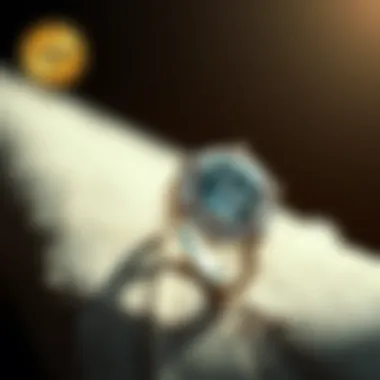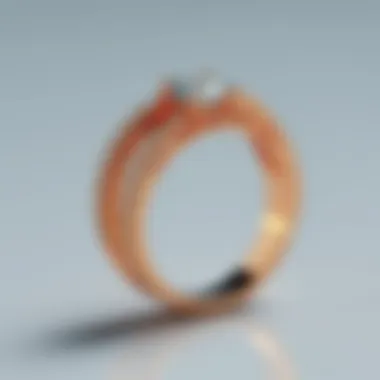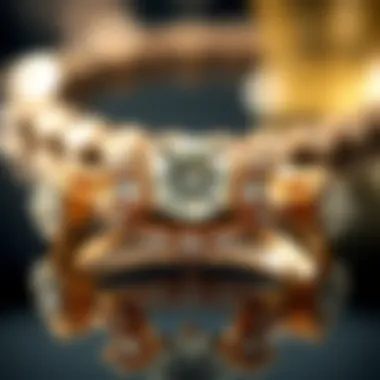Explore the Ladies Ring Size Chart for Perfect Fit


Intro
Understanding ring size is crucial, especially for ladies when selecting the perfect ring. The ladies ring size chart is more than just numbers; it is about ensuring comfort and style. Whether it’s for an engagement, a holiday gift, or simply a personal purchase, the right fit can make all the difference. Many people believe that sizing is a straightforward process, but there are subtle complexities behind ring sizing that are vital to grasp.
Accurate sizing doesn't just enhance wearability but also showcases the beauty of the piece. In this guide, we’ll unpack different methodologies and insights into how to approach sizing with confidence. From learning about measurements to considering the impact of various ring styles, this will help you navigate the often daunting task of finding the right size. Let's roll up our sleeves and dive in!
Prelude to Ring Sizing
When it comes to purchasing jewelry, particularly rings, understanding the fundamentals of ring sizing is absolutely paramount. An accurate ring size is not just a number; it is a key that unlocks the door to comfort and satisfaction. A ring that fits well not only enhances the aesthetics of the piece but also ensures that it can be worn comfortably throughout the day. In essence, the right size can make or break the experience of wearing a cherished piece of jewelry.
So, what exactly makes ring sizing so significant? For starters, many factors come into play when determining the perfect fit. These include the finger's shape, the type of ring being worn, and even how the body reacts to changes in temperature and physical activity. If a ring is too tight, it can cause discomfort or even damage to the finger over time. Conversely, a ring that is too loose might slide off or get caught on objects, leading to the potential for loss—which is definitely not a pleasant experience for any jewelry lover.
Moreover, the process of sizing varies greatly across different cultures and regions. Understanding these nuances can save an individual a great deal of frustration and heartache. For collectors and jewelry designers, grasping the specifics of ring sizing allows for more precise work when crafting or selecting pieces meant to appeal to various audiences.
In light of these considerations, the following sections delve deeper into the intricacies of ring sizes and will explore the specific measurements used, common sizing systems, and the importance of tailoring sizes to individual needs. This knowledge provides essential insights, setting the stage for a richer understanding of the ladies ring size chart.
Importance of Accurate Ring Size
Finding the right size for a ring goes beyond preferences; it actually can define the longevity of the jewelry wearer's enjoyment. Imagine the disappointment of receiving a beautiful ring only to find it pinching uncomfortably or, worse yet, not staying put on the finger at all. The accuracy of sizing plays a crucial role in ensuring a piece remains cherished instead of becoming a mere relic tucked away in a jewelry box.
When rings are custom designed or handcrafted, precision in sizing becomes critical. For instance, if a jeweler is crafting a bespoke piece, a misstep in measurement can lead to financial loss and emotional dismay for both the creator and the recipient. Thus, taking the time to ascertain an accurate ring size is not simply a recommendation; it should be viewed as a non-negotiable step in any jewelry transaction.
“A good fit is what makes a ring a joy to wear. Without it, the beauty of the piece can easily be overshadowed by discomfort.”
Common Challenges in Sizing
Despite its importance, determining the correct ring size does come with its share of challenges. One common issue is misunderstanding or miscommunication about sizes, particularly when buyers are unfamiliar with the different sizing systems used around the world. In some situations, the system one person is accustomed to may not align with another's, leading to confusion.
Another challenge lies in the natural fluctuations of finger size. Factors like heat, humidity, and even time of day can influence how your fingers feel, making true sizing somewhat elusive. Additionally, body changes due to weight, hormonal shifts, or health issues can also lead to variations in ring fit, presenting ongoing obstacles for those who desire a perfect size year-round.
Moreover, a ring's design can significantly influence sizing decisions. Wider bands, for instance, may require a different fit than thinner styles due to how they sit against the finger. All these discrepancies can lead to hesitation when choosing the right ring, emphasizing once again the value of understanding the sizing process and utilizing available resources effectively.
In summary, navigating the challenges of ring sizing is no small feat. However, recognizing these issues equips enthusiasts and buyers with the knowledge needed to avoid missteps and ensure that their rings fit as intended.
Understanding Ring Sizes
Understanding ring sizes is crucial not just for the artisans crafting beautiful pieces, but for those purchasing or wearing rings. Accurate sizing ensures comfort and longevity of wear. When a ring fits well, it is less likely to slip off or feel constricting. This article dives deep into the elements that make up various ring sizes, as well as the implications this has for design and practicality.
Standard Sizing Systems
When it comes to rings, the sizing systems vary significantly across different regions. This section breaks down the three primary systems: US, UK, and European, each with its distinct attributes.
US Ring Size System
The US Ring Size System operates on a simple numerical scale that ranges from size 3 to size 13, with half sizes in between. A key characteristic of this system is its straightforward structure. Each size corresponds to specific internal measurements, making it easy to understand. The main appeal is that it's familiar to most Americans, which eliminates confusion when buying jewelry locally.
One unique feature of this system is how it may not accurately reflect sizes for different ring styles. For instance, a wider band may require a larger size than a more slender one. This nuance can lead to purchasing errors, making the awareness of differences between styles vital when using this sizing system.
UK Ring Size System
The UK Ring Size System is a letter-based approach, ranging from A to Z. Each letter indicates a size, with increments of approximately 0.3 mm in internal diameter. The charm of this system lies in its uniform scale; however, it can be confusing if someone is accustomed to the numeric US system. Often, UK sizes are less frequently referenced online, which can lead to extra effort when researching or purchasing rings.
Another notable aspect is its reflection of the ring’s fit, as larger sizes can signal a more definitive narrowing in size increments. However, one could argue that the added complexity of memorizing letter sizes is a drawback for some users compared to the more straightforward US system.
European Ring Size System
The European Ring Size System is based on the circumference of the finger, measured in millimeters. This system has a reputation for precision. The measurement method allows for a more intimate fit, often preferred by jewelers crafting bespoke pieces. Each size translates directly to the circumference, which can make purchasing rings easier when the consumer is armed with their precise measurements.
However, the downside is that this system may be less intuitive for those unfamiliar with metric measurements. The transition to metric can be a hurdle for buyers from the US or UK, making it necessary to have a reliable conversion guide close at hand when shopping across regions.
Overview of Size Measurements
Ring size measurement generally falls within two categories: internal diameter and circumference. Both aspects contribute to the understanding of how snugly a ring will fit on the wearer's finger.
Internal Diameter
Internal diameter refers to the width of the ring, measured across its center. The primary advantage here is the straightforward nature of measurement—it gives a clear idea of how a ring will fit. Jewelers typically refer to internal diameter in millimeters, allowing for easy comparisons across different rings. With many modern tools available today, it can be efficiently determined at home with a ruler or a ring gauge.


However, one drawback is that not all individuals know their accurate internal diameter size. As a result, without proper guidance, one might miscalculate their size, which could lead to a disappointing purchase.
Circumference
Circumference, on the other hand, offers a rounded view of how a ring will fit, as it measures the entire length around the finger. This characteristic provides insight into overall fit. It reflects the snugness of a ring as it wraps around, eliminating any chance of it slipping off. A clear advantage here is the allowance for adjustments. Jewelers can easily resize rings based on circumference measurements.
However, measuring circumference can be tricky without the right tools. A common mistake is not accounting for factors like the shape of a finger, which may impact the overall comfort of the ring if it's merely sized based on circumference alone.
"A well-fitting ring is not just a piece of jewelry; it’s a reflection of thoughtfulness for the wearer’s comfort."
Treading through the waters of ring sizing may seem trivial at first glance, but it holds great significance for both designers and wearers alike.
Ladies Ring Size Chart
The chart serves as a guide, integrating various sizing systems and measurements that align with individual preferences and anatomical variances. From casual to formal wear, finding the perfect ring starts with grasping the nuances of how sizes are structured and how they can differ from one brand to another.
Chart Overview
Size Intervals
Size intervals within the ladies ring size chart define the small increments between sizes that can significantly affect fit. Generally, a half-size difference exists, and these intervals play a vital role in ensuring that rings fit snugly without pinching or sliding off.
What's noteworthy about size intervals is their adaptability for different styles. A ring with intricate setting might require a different fit compared to a smooth band, leading to the conclusion that one must consider the style along with the size. The advantage here is clear: more defined intervals provide a greater likelihood of achieving a comfortable fit. However, this can also introduce complexity when selecting a size based solely on the chart without accounting for personal variations.
Conversion Tables
Conversion tables serve as a bridge for understanding sizes across various international systems like the U.S., U.K., and European sizing. They break down the numbers into a more digestible format for anyone involved in ring purchasing or customization.
A key characteristic of these conversion tables is their ability to simplify the process. For instance, someone accustomed to U.S. sizes may find themselves lost navigating through European standards. With a glance at a conversion table, one can easily see that a U.S. size 7 aligns with a European size 54. This ability to contrast and convert enhances accessibility and understanding, thus mitigating the chances of errors in selection. However, it's worthwhile to note that discrepancies can arise based on the manufacturer’s own sizing standards.
Average Ring Sizes for Women
Trends in Ring Sizes
The trends in ring sizes significantly reflect cultural shifts, lifestyle changes, and even broader societal standards of beauty. For example, many women today are opting for unique, statement pieces rather than traditional settings. This trend informs the average sizes available in stores, as demand is a driving factor.
Interestingly, there's been a noticeable increase in the average ring size over the years. Many attribute this to lifestyle changes—more women are engaging in sports and activities that can impact finger size. By recognizing these trends, both buyers and designers can make informed choices aligning with current preferences, which can also guide them in creating unique pieces that resonate emotionally.
Factors Influencing Size Choices
Several factors influence the choices women make regarding ring sizes. Lifestyle is paramount; those who lead active lives may prefer fit that is neither too tight nor too loose, prompting a different sizing consideration compared to those whose daily routine is generally sedentary.
Moreover, environmental elements such as temperature fluctuations can affect finger size due to swelling or contraction. For instance, during warmer weather, someone might find their rings feeling a bit tighter, while in the cold they may slip a little more easily. Recognizing these influences allows one to be more agile in their size choices, ensuring that the perfect ring remains comfortable in all circumstances.
Ultimately, understanding the intricacies associated with ladies ring sizes not only assists buyers but contributes depth to the jewelry buying experience, combining both aesthetics and comfort.
Methods for Determining Ring Size
When it comes to finding the perfect fit for a ring, understanding the right methods for determining ring size is crucial. This section sheds light on various ways to ascertain an accurate measurement, ensuring that whether it’s an engagement or a fashion ring, it will sit comfortably and securely on the finger. Missteps in sizing can lead to frustration and financial loss, making it essential to get this process right.
Measuring Your Own Ring Size
This approach is quite pragmatic and gives you a sense of autonomy. Utilizing self-measurement techniques allows individuals to determine their own sizes without stepping foot into a shop. The practicality of measuring one’s size at home resonates especially during the current times where visiting stores with ease might not always be an option.
Using a Ring Size Chart
Using a ring size chart has become a popular method among those wanting to gauge their size with minimal fuss. A major highlight of this technique lies in its convenience: you can measure your finger at home, then match your measurement to the appropriate size on the chart. Most charts include both US and European sizing for wider accessibility.
However, one unique feature that sets a ring size chart apart is its simplicity. Just print it out and follow the instructions to see where you land. Though it is an easy and beneficial method, it does have its pitfalls. If the chart isn’t printed to scale, you might end up with incorrect results, so accuracy in this initial setup is critical.
Advantages:
- Convenience: Measure from home.
- Accessibility: Often available online.
Disadvantages:
- Potential for Error: If printed incorrectly, it can lead to faulty sizing.


Employing String or Paper Techniques
The string or paper techniques serve as a less conventional, yet effective method to determine one's ring size. This method involves wrapping a string or strip of paper around the finger where the ring will sit and then measuring the length with a ruler. It’s an approach that appeals to the hands-on learners looking to measure their finger without needing specialized tools.
A key strength of this method is its low-barrier access; almost everyone has a piece of string or paper around. You can adjust it easily until it feels right, making it an adaptable technique. That said, there is a margin for error, particularly if the string or paper isn't taut enough when measured.
Advantages:
- Flexible and Simple: Minimal materials needed.
- Adaptable: You can adjust till comfortable before measuring.
Disadvantages:
- Margin for Error: Must be careful with tension when measuring.
Professional Measurement
While self-sizing is appealing, professional measurement often offers the highest degree of accuracy. Engaging a professional jeweler ensures that even the most ambiguous sizing requests are met with expertise. This method is perfect for those who may be unsure of their size or are looking for a more personalized experience.
Visiting a Jeweler
One way to ensure you're getting an accurate ring size is to visit a jeweler. Professional jewelers have specialized tools designed for measuring a person’s ring size with precision. The process is quick and uncomplicated while also providing you with a sense of reassurance.
What stands out about going to a jeweler is the expertise available. Not only will they take measurements, but they can also offer insights on styles and fit that might not have crossed your mind. However, for those wary of costs, this service might add an extra layer of expense.
Advantages:
- Expertise: Access to professional tools.
- Tailored Advice: Jewelers often provide additional recommendations.
Disadvantages:
- Cost: Visiting a jeweler can incur service fees.
Utilizing Ring Sizers
Another professional option involves using physical ring sizers, which can often be borrowed or even purchased from jewelers. These tools come in varying forms, such as a series of bands that can be tried on the finger, assuring the wearer finds the correct size before purchase. This method is hands-on and might feel more reassuring than charts or other self-measuring methods.
An attractive aspect is that you’re choosing from a selection of sizes, which inherently reduces the likelihood of errors. The downside is that not all jewelers have them readily available, hence sometimes requiring a visit.
Advantages:
- Tactile Experience: Ensures the right feel.
- Low Error Rate: Finding the right ring is easier with a selection to try.
Disadvantages:
- Availability Issues: Not all places will have them in stock.
Factors Affecting Ring Size
Understanding factors affecting ring size is key for anyone involved with jewelry. These elements are intertwined with comfort and fit, guaranteeing that the piece not only looks good but feels right too. Let’s break it down further.
Temperature and Size Fluctuation
This is a huge consideration when talking about ring size. You might not think about it, but did you know that the temperature can change the size of your fingers? For instance, during colder months, fingers tend to shrink slightly, leading to a snug fit. On warmer days, fingers swell; they can feel tight in the late afternoon compared to mornings. This fluctuation can catch you off guard when you’re picking out a ring. If it’s too tight in the heat, it could just be the weather, not the size.
Think about it this way:
- Cold Weather: Fingers shrink, rings may feel loose.
- Warm Weather: Fingers expand, rings may feel tight.
Knowing these changes can help in timing your purchase or ensuring you measure under normal conditions.
Diet and Physical Changes
Diet plays a crucial role too. As people lose or gain weight, their fingers can either swell or shrink. In general, hydration levels can also impact this; when hydrated, you might see more swelling in your fingers.
Some conditions can affect size significantly as well. Pregnancy is a prime example, where many women experience size changes due to natural body shifts. Even minor fluctuations can be important to note. Here’s what to keep in mind:
- Weight Gain: May lead to larger fingers.
- Weight Loss: Often results in smaller finger sizes.
- Hydration Levels: Can change finger width daily.


All of this translates to needing an adaptable framework for ring sizing. Balancing these elements ensures you get that sweet spot for comfort and style.
Having an understanding of how lifestyle choices and environmental factors impact ring fit can save a lot of headache down the line.
As a gemstone enthusiast or a jewelry designer, these insights are invaluable in guiding your choices and ensuring proper sizing for that perfect fit.
Special Considerations for Different Ring Styles
When it comes to selecting the perfect ring, the design plays a pivotal role in determining not just aesthetics but also fit. Different styles bring varied implications on how a ring sits on the finger. Whether one opts for a delicate band or a chunky design, understanding these nuances can make all the difference.
Wide Bands vs. Thin Bands
Choosing between wide and thin bands isn’t just about preference; it’s about how these styles affect measurement and comfort.
Wide bands, while visually striking, tend to fit tighter than they might suggest. This is due to the increased surface area in contact with the skin. Because of this, someone who typically wears a size 6 in a thin band may find that a wide band feels snug at the same size.
- Factors to Consider:
- Comfort Fit: Wide bands can create a constricting feel, especially during warm weather when fingers swell.
- Measuring for Fit: When trying on wide rings, consider going half a size larger to accommodate for this snug fit.
- Aesthetic Appeal: The style of a ring can also affect how it’s perceived visually on the hand. Wider bands often command attention, while thinner bands can feel more subtle.
On the other hand, thin bands often offer a more forgiving fit, making them easier to size. Yet, they can also be less stable on the finger, particularly if they are balanced with larger stones or embellishments.
- Tips for Thin Bands:
- Ensure Proper Alignment: They should comfortably sit without spinning around.
- Consider Band Material: Some materials, like precious metals, can be resized more easily than others, which helps in finding that perfect fit.
Adjustable Rings
Adjustable rings present a fascinating solution to the challenges of sizing. They come with built-in flexibility, making them an excellent option for those who find it hard to pinpoint their size.
However, it’s essential to understand how they function. The adjustability can lead some to believe one size fits all; however, these rings often come with limits in terms of how much they can expand or contract.
- Advantages of Adjustable Rings:
- Considerations:
- Easy to Modify: These rings are great if swelling is an issue, as they can be loosened or tightened as needed.
- Trend Versatility: Many designs range from simple to ornate, allowing wearers to express their style without being tied to a strict size.
- Fit Maintenance: Regular adjustment may be necessary. Ensure it feels secure at all times.
- Style Impact: Some designs may sacrifice some elegance for practicality. It's a balancing act between style and function.
It's vital to find that sweet spot between comfort and style. Knowing the characteristics of different ring styles can change your experience from merely functional to truly personal.
Understanding how these sizing considerations can influence choices ensures that gemstone enthusiasts and jewelry designers alike can find optimal fits that don’t compromise on comfort or style.
Closure and Final Thoughts
In the world of jewelry, understanding ladies' ring sizes is paramount. This knowledge goes beyond mere numbers; it weaves into the very fabric of personal expression. A perfect fit is not just about comfort—it's also about how a piece of jewelry reflects one's individuality and style. When purchasing rings, various factors such as finger shape, width of the band, and even the materials used play a significant role in achieving that ideal size.
Moreover, the significance of accurate sizing cannot be overstated. Whether you're a gemstone enthusiast, a collector, or a jewelry designer, taking the time to ensure that each ring is sized correctly can save you both time and frustration down the road. One wrong size can lead to disappointment, which is something nobody wants to experience when it comes to a cherished piece of jewelry.
"A ring should fit like a glove, not a vise."
Hence, being equipped with in-depth knowledge about sizing charts and the influences that affect these sizes can transform the process of choosing jewelry. By investing in understanding the various sizing systems—be it the US, UK, or European—you can broaden your options and make informed choices that hone in on precision. Additionally, knowing how to measure accurately, whether by oneself or through a professional, adds another layer of assurance.
As we conclude this guide, it’s also important to recognize that jewelry can often symbolize deeper meanings, such as love, commitment, or even personal milestones. An accurate fit enhances not just the physical wearability of a ring but also its emotional value. When a piece fits perfectly, it often translates to a seamless experience of joy and satisfaction, making each occasion special.
By keeping these insights in mind, you'll not only feel empowered while selecting rings but you’ll also ensure that each choice aligns beautifully with your taste and preferences. A well-sized ring leads to lasting happiness—that’s a win-win in anyone’s book.
Summarizing Key Points
In this article, we’ve unpacked several key aspects of understanding the ladies' ring size chart:
- Importance of Accurate Sizing: Knowing your correct size can greatly enhance the joy and comfort of wearing rings.
- Standard Sizing Systems: Familiarity with different systems helps you navigate the ring-buying process efficiently.
- Measuring Techniques: Whether going solo or seeking professional help, mastering the art of measurement is crucial.
- Factors Influencing Size: Understanding how body changes and ring styles can affect size helps you make informed decisions.
- Special Considerations: Recognizing the nuances between wide and thin bands, as well as adjustable rings, adds depth to your understanding.
By embracing these key takeaways, you empower yourself to choose rings that not only fit well but also resonate with personal experience and style.
Encouragement for Accurate Sizing
As we part from this discussion on ring sizes, take a moment to reinforce the importance of accuracy when determining your size. Rushing through the process can lead to regret. Remember, a little diligence in measuring can prevent future mishaps.
Here are some practical tips to consider:
- Take Your Time: Measure your fingers at different times of the day. Sizes can fluctuate, so being thorough gives you the most accurate results.
- Remind Yourself of Style Choices: Keep in mind how ring styles may require different sizing, especially when dealing with wider bands.
- Communicate with Professionals: Don’t hesitate to ask jewelers questions. Their expertise can guide you through custom fittings and sizing options.
- Utilize Technology: Apps and online tools can assist in measurement and conversion—embrace them to streamline your experience.
Ultimately, being proactive about ring sizing ensures the right pieces not only adorn the hand but also complement the spirit. Jewelry is meant to be celebrated, and part of that celebration is wearing it comfortably and confidently.







